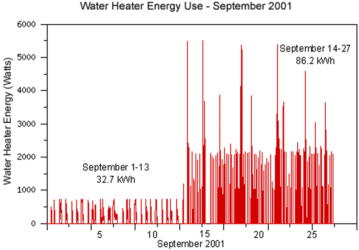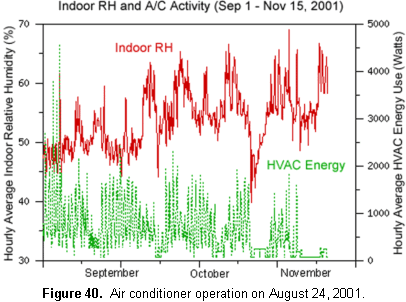| |
|
| |
| Reference
Publication:
Chandra, Subrato, Neil Moyer, Danny Parker, David Beal,
David Chasar, Eric Martin, Janet McIlvaine, Ross McCluney,
Andrew Gordon, Mike Lubliner, Mike McSorley, Ken Fonorow,
Mike Mullens, Mark McGinley, Stephanie Hutchinson, David
Hoak, and Linda Tozer. Building America Industrialized
Housing Partnership, Annual Report - Fourth Budget Period.
04/01/03-03/31/04. |
|
|
| Building
America Industrialized Housing Partnership, Annual
Report - Fourth Budget Period |
|
|
Subrato
Chandra, Neil
Moyer, Danny
Parker, David
Beal, David
Chasar, Eric
Martin, Janet
McIlvaine, Ross
McCluney, Andrew
Gordon, Mike
Lubliner, Mike McSorley, Ken
Fonorow, Mike
Mullens, Mark
McGinley, Stephanie
Hutchinson, David
Hoak, and Linda Tozer |
|
| Florida
Solar Energy Center |
|
| |
|
| Equipment
Features:
•
2-Speed, Zoned Heat Pump: The building envelope design
features described above greatly reduced the required air
conditioner size. Manual-J HVAC equipment-sizing calculations
showed the need for only 2 tons of heating and cooling capacity.
In this case the owner opted for a two-speed compressor, which
provides either 2 or 5 tons of cooling or heating depending
on the need.
Figure
40 (below) shows the air conditioner operation on a typical
hot day summer day in Florida (August 24, 2001). The Hoak
home unit operated in the 2-ton mode until the late afternoon
when it switched to the 5-ton mode for a few brief periods.
In this home, energy use stays low because the low compressor
speed operates the majority of the time. But, when quick
cool-down or excessive loads require more capacity, the high
speed compressor can meet the need.
Measured data indicated that the 5-ton mode
operated about one in every four days during the three hottest
summer months (June to August), usually for periods of 15
minutes or less. Even these short periods of high-speed compressor
operation might have been avoided with proper use of a programmable
thermostat. These results verify the Manual J sizing calculations
and indicate that if a single speed HVAC system were installed,
the optimum size would be 2 to 3 tons. (Please see Table
11.)
| HVAC
System Efficiency |
| Cooling |
Heating |
| SEER
13.35 |
HSPF
- 7.5 |
Table
11. HVAC system cooling and heating efficiencies.
•
Variable-speed Air Handler: Two benefits of
using a variable-speed motor for air distribution are better
moisture removal and energy efficiency. During the cooling
season, slower airflow across a cold coil allows for more
moisture removal. Wintertime comfort also is enhanced with
this operation, since the coil has more time to warm before
the air is brought to full flow.
Indoor
relative humidity tends to increase during the fall and winter
months when air conditioning activity declines. Without a
dedicated dehumidifier, the air conditioner is the only means
of reducing indoor relative humidity. When there is a call
for cooling - the low-speed compressor in a variable speed
system operates more consistently than a larger system and
keeps relative humidity from rising to unhealthy levels.
 |
Figure
41. Heat pump water heater produced all the hot
water needs for a four-person household from April
to September.
|
•
Heat Pump Water Heater: Solar water heating would
have been the first choice for this home, but poor orientation
and too many shade trees forced a search for other options.
(Please see Figure 41.) Natural gas also was unavailable
in the area. To avoid the inefficiency of electric resistance
water heating, a 6,000 BTU/hour heat pump water
heater
was connected to a standard 80-gallon electric water heater.
By locating the heat pump inside the home, homeowners gained
a summertime benefit of additional cooling and year 'round
dehumidification because the system removes moisture each
time it operates.
This
control scheme minimized the electric element use, reserving
these units for backup heating when the heat pump failed to
meet demand. Data collected from April to September of 2001,
showed that the unit produced all the hot water needs for
a four-person household without requiring electric backup
heating. A problem that was later corrected, caused the heat
pump to shutdown midway through September and offered a chance
to compare heat pump and electric resistance performance.
During the first 13 days of September the heat pump used 32.7
kWh, while 86.2 kWh was consumed during the following 13 days
when hot water was supplied solely by electric resistance
elements. Note that hot water use was not monitored during
this period. Figure 42 illustrates the improved efficiency.
 |
Figure
42. Water
heater energy use from September 1 to September 13,
2001. |
• Energy Recovery Ventilator: The energy
recovery ventilator acts as a conduit to flush out stale indoor
air and replace it with outdoor air. As the indoor air is
expelled, a heat exchanger recovers up to 80% of the energy
used to heat or cool the air and transfers it to the incoming
air stream. This unit also transfers a portion of the moisture
between the airstreams, which is useful during periods of
high outdoor humidity.
•
Airtight Ducts: Attic and duct heat gain contribute
to about 22% of the cooling needs of a typical Central Florida
home when are ducts located in a vented attic above the insulation.
While some home efficiency is lost by direct heat-gain through
the duct insulation, a great deal more efficiency can be lost
from unintended duct leakage from the ductwork into the vented
attic. Duct leakage test results showed only 50 CFM of air
was lost at 25 Pa of pressure differential in the Hoak residence.
This leakage equates to 1.2% leakage per square foot of conditioned
floor area - far below the leakage normally found in new Florida
homes.
|
Disclaimer:
This report was prepared as an account of work sponsored by an agency
of the United States government. Neither the United States government
nor any agency thereof, nor any of their employees, makes any
warranty, express or implied, or assumes any legal liability
or responsibility for the accuracy, completeness, or usefulness
of any information, apparatus, product, or process disclosed,
or represents that its use would not infringe privately owned
rights. Reference herein to any specific commercial product,
process, or service by trade name, trademark, manufacturer,
or otherwise does not necessarily constitute or imply its endorsement,
recommendation, or favoring by the United States government
or any agency thereof. The views and opinions of authors expressed
herein do not necessarily state or reflect those of the United
States government or any agency thereof.
|






